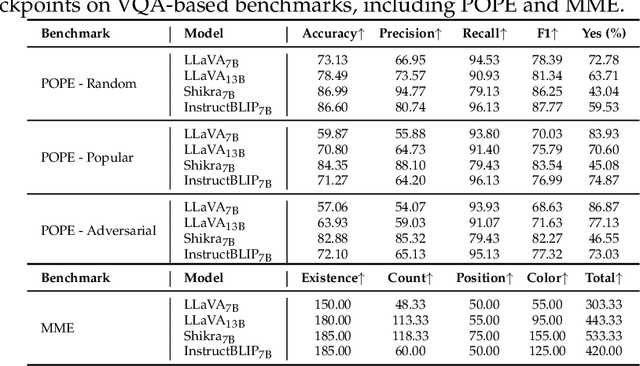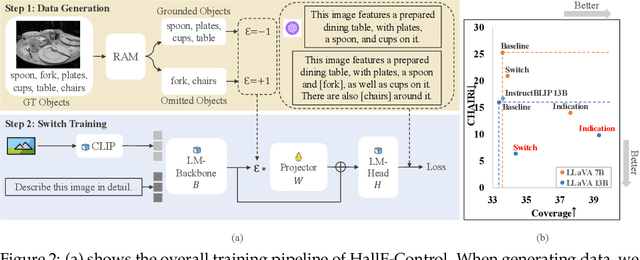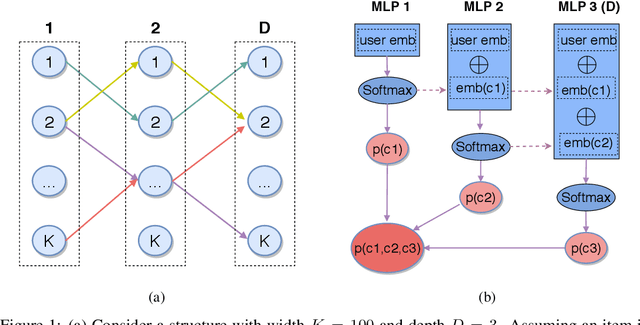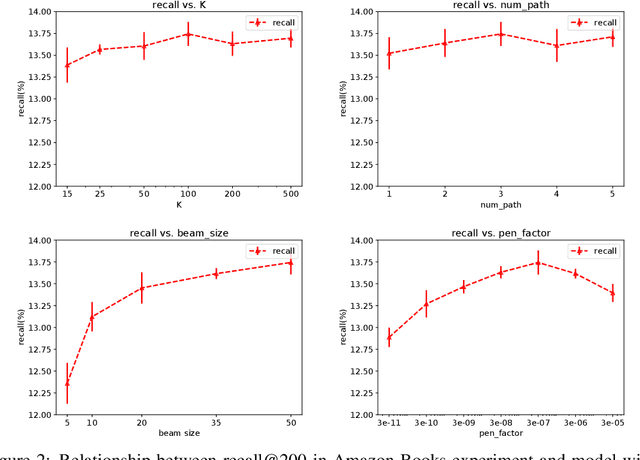Xiangjun Fan
GEM: Empowering LLM for both Embedding Generation and Language Understanding
Jun 04, 2025Abstract:Large decoder-only language models (LLMs) have achieved remarkable success in generation and reasoning tasks, where they generate text responses given instructions. However, many applications, e.g., retrieval augmented generation (RAG), still rely on separate embedding models to generate text embeddings, which can complicate the system and introduce discrepancies in understanding of the query between the embedding model and LLMs. To address this limitation, we propose a simple self-supervised approach, Generative Embedding large language Model (GEM), that enables any large decoder-only LLM to generate high-quality text embeddings while maintaining its original text generation and reasoning capabilities. Our method inserts new special token(s) into a text body, and generates summarization embedding of the text by manipulating the attention mask. This method could be easily integrated into post-training or fine tuning stages of any existing LLMs. We demonstrate the effectiveness of our approach by applying it to two popular LLM families, ranging from 1B to 8B parameters, and evaluating the transformed models on both text embedding benchmarks (MTEB) and NLP benchmarks (MMLU). The results show that our proposed method significantly improves the original LLMs on MTEB while having a minimal impact on MMLU. Our strong results indicate that our approach can empower LLMs with state-of-the-art text embedding capabilities while maintaining their original NLP performance
S'MoRE: Structural Mixture of Residual Experts for LLM Fine-tuning
Apr 08, 2025Abstract:Fine-tuning pre-trained large language models (LLMs) presents a dual challenge of balancing parameter efficiency and model capacity. Existing methods like low-rank adaptations (LoRA) are efficient but lack flexibility, while Mixture-of-Experts (MoE) architectures enhance model capacity at the cost of more & under-utilized parameters. To address these limitations, we propose Structural Mixture of Residual Experts (S'MoRE), a novel framework that seamlessly integrates the efficiency of LoRA with the flexibility of MoE. Specifically, S'MoRE employs hierarchical low-rank decomposition of expert weights, yielding residuals of varying orders interconnected in a multi-layer structure. By routing input tokens through sub-trees of residuals, S'MoRE emulates the capacity of many experts by instantiating and assembling just a few low-rank matrices. We craft the inter-layer propagation of S'MoRE's residuals as a special type of Graph Neural Network (GNN), and prove that under similar parameter budget, S'MoRE improves "structural flexibility" of traditional MoE (or Mixture-of-LoRA) by exponential order. Comprehensive theoretical analysis and empirical results demonstrate that S'MoRE achieves superior fine-tuning performance, offering a transformative approach for efficient LLM adaptation.
CAFe: Unifying Representation and Generation with Contrastive-Autoregressive Finetuning
Mar 25, 2025Abstract:The rapid advancement of large vision-language models (LVLMs) has driven significant progress in multimodal tasks, enabling models to interpret, reason, and generate outputs across both visual and textual domains. While excelling in generative tasks, existing LVLMs often face limitations in tasks requiring high-fidelity representation learning, such as generating image or text embeddings for retrieval. Recent work has proposed finetuning LVLMs for representational learning, but the fine-tuned model often loses its generative capabilities due to the representational learning training paradigm. To address this trade-off, we introduce CAFe, a contrastive-autoregressive fine-tuning framework that enhances LVLMs for both representation and generative tasks. By integrating a contrastive objective with autoregressive language modeling, our approach unifies these traditionally separate tasks, achieving state-of-the-art results in both multimodal retrieval and multimodal generative benchmarks, including object hallucination (OH) mitigation. CAFe establishes a novel framework that synergizes embedding and generative functionalities in a single model, setting a foundation for future multimodal models that excel in both retrieval precision and coherent output generation.
Beyond Reward Hacking: Causal Rewards for Large Language Model Alignment
Jan 16, 2025



Abstract:Recent advances in large language models (LLMs) have demonstrated significant progress in performing complex tasks. While Reinforcement Learning from Human Feedback (RLHF) has been effective in aligning LLMs with human preferences, it is susceptible to spurious correlations in reward modeling. Consequently, it often introduces biases-such as length bias, sycophancy, conceptual bias, and discrimination that hinder the model's ability to capture true causal relationships. To address this, we propose a novel causal reward modeling approach that integrates causal inference to mitigate these spurious correlations. Our method enforces counterfactual invariance, ensuring reward predictions remain consistent when irrelevant variables are altered. Through experiments on both synthetic and real-world datasets, we show that our approach mitigates various types of spurious correlations effectively, resulting in more reliable and fair alignment of LLMs with human preferences. As a drop-in enhancement to the existing RLHF workflow, our causal reward modeling provides a practical way to improve the trustworthiness and fairness of LLM finetuning.
Quantifying Generalization Complexity for Large Language Models
Oct 02, 2024Abstract:While large language models (LLMs) have shown exceptional capabilities in understanding complex queries and performing sophisticated tasks, their generalization abilities are often deeply entangled with memorization, necessitating more precise evaluation. To address this challenge, we introduce Scylla, a dynamic evaluation framework that quantitatively measures the generalization abilities of LLMs. Scylla disentangles generalization from memorization via assessing model performance on both in-distribution (ID) and out-of-distribution (OOD) data through 20 tasks across 5 levels of complexity. Through extensive experiments, we uncover a non-monotonic relationship between task complexity and the performance gap between ID and OOD data, which we term the generalization valley. Specifically, this phenomenon reveals a critical threshold - referred to as critical complexity - where reliance on non-generalizable behavior peaks, indicating the upper bound of LLMs' generalization capabilities. As model size increases, the critical complexity shifts toward higher levels of task complexity, suggesting that larger models can handle more complex reasoning tasks before over-relying on memorization. Leveraging Scylla and the concept of critical complexity, we benchmark 28LLMs including both open-sourced models such as LLaMA and Qwen families, and close-sourced models like Claude and GPT, providing a more robust evaluation and establishing a clearer understanding of LLMs' generalization capabilities.
HallE-Switch: Rethinking and Controlling Object Existence Hallucinations in Large Vision Language Models for Detailed Caption
Oct 03, 2023



Abstract:Current large vision-language models (LVLMs) achieve remarkable progress, yet there remains significant uncertainty regarding their ability to accurately apprehend visual details, that is, in performing detailed captioning. To address this, we introduce \textit{CCEval}, a GPT-4 assisted evaluation method tailored for detailed captioning. Interestingly, while LVLMs demonstrate minimal object existence hallucination in existing VQA benchmarks, our proposed evaluation reveals continued susceptibility to such hallucinations. In this paper, we make the first attempt to investigate and attribute such hallucinations, including image resolution, the language decoder size, and instruction data amount, quality, granularity. Our findings underscore the unwarranted inference when the language description includes details at a finer object granularity than what the vision module can ground or verify, thus inducing hallucination. To control such hallucinations, we further attribute the reliability of captioning to contextual knowledge (involving only contextually grounded objects) and parametric knowledge (containing inferred objects by the model). Thus, we introduce $\textit{HallE-Switch}$, a controllable LVLM in terms of $\textbf{Hall}$ucination in object $\textbf{E}$xistence. HallE-Switch can condition the captioning to shift between (i) exclusively depicting contextual knowledge for grounded objects and (ii) blending it with parametric knowledge to imagine inferred objects. Our method reduces hallucination by 44% compared to LLaVA$_{7B}$ and maintains the same object coverage.
Deep Retrieval: An End-to-End Learnable Structure Model for Large-Scale Recommendations
Jul 12, 2020



Abstract:One of the core problems in large-scale recommendations is to retrieve top relevant candidates accurately and efficiently, preferably in sub-linear time. Previous approaches are mostly based on a two-step procedure: first learn an inner-product model and then use maximum inner product search (MIPS) algorithms to search top candidates, leading to potential loss of retrieval accuracy. In this paper, we present Deep Retrieval (DR), an end-to-end learnable structure model for large-scale recommendations. DR encodes all candidates into a discrete latent space. Those latent codes for the candidates are model parameters and to be learnt together with other neural network parameters to maximize the same objective function. With the model learnt, a beam search over the latent codes is performed to retrieve the top candidates. Empirically, we showed that DR, with sub-linear computational complexity, can achieve almost the same accuracy as the brute-force baseline.
 Add to Chrome
Add to Chrome Add to Firefox
Add to Firefox Add to Edge
Add to Edge